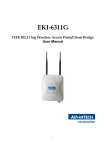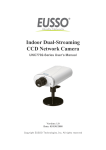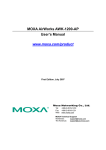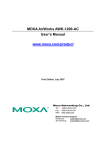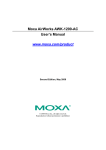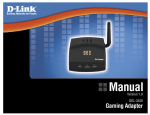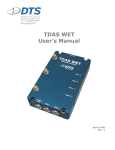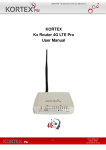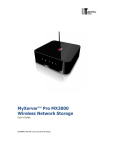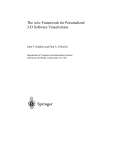Download Eusso UOW2000 Series User`s manual
Transcript
Wireless-G Outdoor PoE AP User’s Manual BEFORE INST ALLING THE UNIT, PLEASE RE AD THIS M ANU AL THOROUGHLY, AND RET AIN IT FOR FUTURE REFERENCE. Copyright 2008 EUSSO Technologies, Inc. All rights reserved. 1 ► Contents Chapter 1. Introduction............................................................................................... 4 1.1 Introducing the UOW2000 Series............................................................ 4 1.2 Product Features ....................................................................................... 4 1.3 Package Contents ...................................................................................... 4 1.4 System Requirements ............................................................................... 5 1.5 Inline Power Injector (PoE) ..................................................................... 5 Chapter 2. Installation and Basic Configuration ...................................................... 6 2.1 Before You Start ........................................................................................ 6 2.2 Locate the UOW2000 Series and Inline Power Injector Ports ............. 7 2.3 Preparing Installation............................................................................... 9 2.4 Basic Configuration ................................................................................ 10 2.4.1 Basic Configuration Steps ................................................. 10 2.4.2 Logging into the Web Interface..................................... 10 2.4.3 Set Operating Mode, IP Address, Subnet Mask, Default Route IP, DNS Server IP of UOW2000 Series ..... 13 2.4.4 Set Wireless SSID for Wireless Interface................ 15 2.4.5 Set Wireless Encryption for Wireless Interface ... 16 2.4.6 Change Supervisor Account & Password ................. 17 2.4.7 Upgrade the Firmware......................................................... 18 Chapter 3. Network Topologies................................................................................. 19 3.1 Wireless Client Bridge-to-Central Wireless Bridge............................. 20 Chapter 4. All function on Device............................................................................. 21 4.1 BASIC ...................................................................................................... 21 4.1.1 Wizard ........................................................................................... 21 4.1.2 LAN .................................................................................................. 23 4.1.3 DHCP............................................................................................... 25 4.1.4 WIRELESS.................................................................................... 30 4.2 ADVANCED ............................................................................................ 35 4.2.1 MAC Address Filter................................................................. 35 4.2.2 Advance Wireless ................................................................... 37 4.3 TOOLS..................................................................................................... 39 4.3.1 Admin............................................................................................. 39 4.3.2 Time ................................................................................................ 42 4.3.3 System........................................................................................... 44 4.3.4 Firmware...................................................................................... 45 4.4 Status ........................................................................................................ 47 4.4.1 Device Info ................................................................................. 47 4.4.2 Logs................................................................................................. 49 4.4.3 Statistics ...................................................................................... 51 Chapter 5. Specifications ........................................................................................... 53 Chapter 6. Default Settings ....................................................................................... 56 6.1 BASIC ...................................................................................................... 56 2 6.1.1 WIZARD ........................................................................................ 56 6.1.2 LAN .................................................................................................. 57 6.1.3 DHCP............................................................................................... 57 6.1.4 WIRELESS.................................................................................... 58 6.2 ADVANCE ............................................................................................... 59 6.2.1 MAC Address Filter............................................................................ 59 6.2.2 Advanced Wireless .............................................................................. 59 6.3 TOOLS..................................................................................................... 59 6.3.1 ADMIN................................................................................................. 59 6.3.2 TIME.................................................................................................... 60 6.3.3 SYSTEM .............................................................................................. 60 6.3.4 FIRMWARE........................................................................................ 60 3 Chapter 1. 1.1 Introduction Introducing the UOW2000 Series The UOW2000 Series is fully interoperable with IEEE 802.11a and/or 802.11b/g compliant Outdoor Wireless Last-mile product. The UOW2000 SERIES operates in AP mode or remote bridge mode, and connects to UOW2000 SERIES AP/CB to construct point-to-point as well as point-to-multipoint topologies, for maximum flexibility in configuring building-to-building networks and WISP functions. 1.2 Product Features Outdoor enclosure in compliance with versatile industrial IP (Ingress Protection) level covering IP67, IP66, IP55 and IP50 RF transmit power 802.11b mode @ 11Mbps data rate RF transmit power 802.11g mode @ 54Mbps data rate Support 48VDC 0.375A Power-over-Ethernet(PoE) NAT/NAPT and Virtual Server Mapping support (Optional / RB only) MIB-I support MAC address based access control ¾ ¾ ¾ ¾ ¾ ¾ ¾ Hint: IP(Ingress Protection) 1.3 Package Contents The product package contains the following items. 1. One (1) UOW2000 Series Outdoor Wireless Access Point / Client 2. 3. 4. 5. 6. 7. 8. 9. Bridge unit One (1) 100~240VAC, 50~60Hz AC to 48V/0.375A DC switching adapter One (1) 48VDC, 0.375A Inline Power Injector (PoE) One (1) 30m RJ-45 CAT-5 Ethernet cable One (1) 1.8m RJ-45 CAT-5 Cross Over Cable One (1) 1.8m grounding wire One (1) User manual CD-disc One (1) wall/mast mounting kit One (1) band clamp 4 1.4 System Requirements Installation of the UOW2000 Series Outdoor Wireless Access Point/Client Bridge requires the following: 1. A Windows-based PC/AT compatible computer ( PC system requirement:better than PIII 800 or other 100% compatible equipment , OS: windows 2000/XP ) or Ethernet data device with an available RJ-45 Ethernet port to run the configuration program or with TCP/IP connection to the Ethernet network. 2. A 10/100Base-T Ethernet RJ-45 Ethernet cable is connected to Ethernet network. 3. An AC power outlet (100~240V, 50~60Hz) supplies the power. 1.5 Inline Power Injector (PoE) The UOW2000 Series is equipped with an Inline Power Injector module. The Inline Power Injector (PoE) delivers both data and power to UOW2000 Series unit via a signal Ethernet cable, and gives the following benefits to improve the performance vs. installation cost ratio. ¾ This works great in areas where you may not have power , like house roof. ¾ This also allows you to place the UOW2000 Series unit closer to the antenna, to make installation easier more thus reducing signal loss over antenna cabling. ¾ Ethernet signal travels well over CAT 5 cable but 2.4GHz signal doesn't do as well over antenna cabling. ¾ Ethernet cabling is much cheaper than Antenna cabling. 5 Chapter 2. Installation and Basic Configuration This chapter describes the procedures of installing the UOW2000 Series. 2.1 Before You Start After unpacking the system, make sure the following items are present and in good condition. Refer to below pictures for product image. 1. UOW2000 Series Outdoor Wireless Access Point/Client Bridge unit 2. 100~240VAC, 50~60Hz AC to 48V/0.375A DC switching adapter 3. Inline Power Injector (PoE) 48VDC, 0.375A 4. RJ-45 CAT-5 Ethernet cable 30 m 5. RJ-45 CAT-5 Cross-over Ethernet cable 1.8m 6. Grounding wire 1.8m 7. User manual CD-disc 8. Wall/mast mounting kit, including one (1) band clamp 9. Screws 10. 5dBi Oimi-type Antenna (for AP) 1. Unit 2. Adapter 3. PoE 4. 30m cable (Optional) 5. 1.8m cable (Optional) 6. Grounding wire 7. CD 8. Wall mount 9. Screws 10. Antenna(for AP) 6 2.2 Locate the UOW2000 Series and Inline Power Injector Ports ► Interface on the UOW2000 Series Unit ¾ Ethernet Port 1 : for connecting the 30m RJ-45 CAT-5 Ethernet cable. ► Interface on the Inline Power Injector ¾ Data Input Port 2 : for connecting cross-over Ethernet Cable to PC or straight Ethernet cable to Hub Switch Router . ¾ DC Input Port 3 : power adapter 48V, 0.375A DC input. ¾ Power & Data Output Port 4 : for connecting the 30m RJ-45 CAT-5 Ethernet Cable. ¾ Grounding Port 5 : for connecting grounding wire. Device 4 5 2 3 POE picture1 1 POE picture2 Figure 2-1 Power and Data Interface location on the PoE denoted by numbers 1-6. 7 ► Mount UOW2000 Series on A Wall/Mast The UOW2000 Series can be mounted on the wall, you can use the Wall Mount kit to mount the UOW2000 Series as shown in Figure 2-2. Figure 2-2 You can also mount the UOW2000 Series to the mast as shown in Figure 2-3. Figure 2-3 8 2.3 Preparing Installation Before installing UOW2000 Series for outdoor application or hard-to-reach location, we recommend configuring and test all the devices first. For configuring the UOW2000 Series, please follow the quick steps below to power up the UOW2000 Series. Refer to Figure 2-4 for steps 1 through 5. Figure 2-4 Step1 : Connect the DC plug of the AC/DC power adapter into the DC Input Port of Inline Power Injector and the wall-mount plug into a power outlet or power strip (refer to page 6). The Power LED on the Inline Power Injector will light up. Step2 : Run the cross-over type uplink Ethernet cable from Data Input Port (refer topage 6) to the Ethernet port on a PC. Step3 : Connect the 30m CAT 5 Ethernet cable into the UOW2000 Series unit. Hand tighten the connector. Step4 : Connect the remaining end of the 30m CAT 5 cable into the PoE labeled AP/Bridge. This is the power side of the PoE that will power up the UOW2000 Series. When the UOW2000 Series receives power over the Ethernet cable, the UOW2000 Series will start its boot up sequence and the Active LED on the Inline Power Injector will light up. You can configure the UOW2000 Series via HTML browser, such as Microsoft Internet Explorer or Netscape Navigator from a remote host or PC. 9 2.4 2.4.1 Basic Configuration Basic Configuration Steps This section describes a two-step BASIC configuration procedure to setup UOW2000 Series. Step1 : Modify the factory-default parameters on the web page “/BASIC/LAN/”, and click Save Settings to save the changes, than click Continue . Step2 : Modify the factory-default parameters on the web page “/BASIC/Wireless/”, and click Save Settings to save the changes, than click Reboot the Device to take effect on the previous configuration changes. 2.4.2 Logging into the Web Interface The UOW2000 Series supports access to the configuration system through the use of an HTTP Interface. ► Web Configuration Before configuring UOW2000 series, the user needs to know the IP Address assigned to the unit. When shipped from the factory, the IP Address 192.168.1.1 was assigned to the UOW2000 Series by default. To start a web connection, use http://192.168.1.1 ► Web Access Procedures Once you identify the IP Address assigned to UOW2000 Series, use web browser to configure UOW2000 SERIES through the HTTP Interface. The following procedure explains how to configure each item. Step1 : Open your browser and enter the IP Address Step2 : Press <ENTER> key and the UOW2000 Series Login screen appears as shown in Figure 2-5. 10 Figure 2-5 Step3 : Enter “admin” in the Password fields, and click Log In to enter the web configuration user interface screen as shown below. Figure 2-6 ► Web Configuration Structure The web configuration user interface shown above in Figure 2-6 is grouped into a tree structure, and contains the following settings or information. 11 ▽ BASIC ● WIZARD ● LAN ● DHCP ● WIRELESS ▽ ADVANCED ● MAC ADDRESS FILTER ● ADVANCED WIRELESS ▽ TOOLS ● ADMIN ● TIME ● SYSTEM ● FIRMWARE ▽ STATUS ● DEVICE INFO ● WIRELESS ● LOGS ● STATISTICS ▽ HELP ● MENU ● BASIC ● ADVANCED ● TOOLS ● STATUS ● GLOSSARY Move through the tree by clicking on an icon to expand or collapse the tree. The nodes on the tree represent web pages that allow viewing and modifying the parameters. 12 2.4.3 Set Operating Mode, IP Address, Subnet Mask, Default Route IP, DNS Server IP of UOW2000 SERIES ► LAN Settings These are the settings of the LAN (Local Area Network) interface for the Access Point. The Access Point's local network (LAN) settings are configured based on the IP Address and Subnet Mask assigned in this section. The IP address is also used to access this Web-based management interface. This option is available in the “/BASIC/LAN/” page as shown in Figure 2-7. Figure 2-7 ► Get LAN IP From Choose "DHCP (Dynamic)" if your router supports DHCP and you want the router to assign an IP address to the AP. In this case, you do not need to fill in the following fields. Choose "Static IP (Manual)" if your router does not support DHCP or if for any other reason you need to assign a fixed address to the AP. In this case, you must also configure the following fields. Note that you cannot choose "DHCP (Dynamic)" if you have enabled the "DHCP Server" option on the DHCP page; the AP cannot be both a DHCP client and a DHCP server. ► IP Address 13 The IP address of the AP on the local area network. Assign any unused IP address in the range of IP addresses available for the LAN. For example, 192.168.0.1. ► Subnet Mask The subnet mask of the local area network. ► Gateway The IP address of the router on the local area network. ► Local Domain Name This entry is optional. Enter a domain name for the local network. The AP's DHCP server will give this domain name to the computers on the wireless LAN. So, for example, if you enter mynetwork.net here, and you have a wireless laptop with a name of chris, that laptop will be known as chris.mynetwork.net. Note, however, if the AP's settings specify "DHCP (Dynamic)" Address, and the router's DHCP server assigns a domain name to the AP, that domain name will override any name you enter here. 14 2.4.4 Set Wireless SSID for Wireless Interface ► Wireless Network Name (Also called the SSID) When you are browsing for available wireless networks, this is the name that will appear in the list (unless Visibility Status is set to Invisible, see below). This name is also referred to as the SSID. For security purposes, it is highly recommended to change from the pre-configured network name. This option is available in the “/BASIC/WIRELESS/” page as shown in Figure 2-8 Figure 2-8 15 2.4.5 Set Wireless Encryption for Wireless Interface The UOW2000 Series supports 64-bit and 128-bit WEP encryption. For 64-bit WEP encryption, an encryption key is 10 hexadecimal characters (0-9 and A-F) or 5 ASCII characters. For 128-bit WEP encryption, an encryption key is 26 hexadecimal characters or 13 ASCII characters. Modify the WEP encryption parameters on the web page “/BASIC/WIRELESS/WIRELESS SECURITY MODE”. Choice “WEP” Enter 1~15 characters into the WEP Key field, than click Save Setting ,Reboot the Device. 16 2.4.6 Change Supervisor Account & Password Enter the TOOLS > ADMIN page. Figure 2-9 below shows the TOOLS/ ADMIN page. Figure 2-9 ► ADMIN PASSWORD Change the ADMIN PASSWORD’s user name and password in the ADMIN PASSWORD Account field, and click Save Setting ,than Reboot the Device. to take effect on the previous configuration changes. 17 2.4.7 ► Upgrade the Firmware Update the Firmware Enter the TOOLS > FIRMWARE page as shown in Figure 2-10 to upgrade UOW2000 Series. Here, user must select which file you want to upgrade it (Program image), then click Upload button to start the upgrade process. Hint: It takes about 1 min, to complete the restart process. Figure 2-10 Caution The Part 15 radio device operates on a non-interference basis with other devices operating at this frequency when using integrated antennas. Any changes or modification to the product not expressly approved by Original Manufacture could void the user's authority to operate this device. Caution To meet regulatory restrictions and the safety of the installation, product to be professionally installed. 18 strongly recommends this Chapter 3. Network Topologies This chapter describes several common types of installations implemented by using the UOW2000 Series’s line of Outdoor Wireless System. This is by no means intended to be an exhaustive list of all possible configurations, but rather shows examples of some of the more common implementations. The UOW2000 Series CB can be configured to function as a Wireless Client Router or Bridge to a central access point like the UOW2000 Series AP see Figure 3-1 below. Figure 3-1 The UOW2000 Series CB performs in either router or bridge mode. In a Point-to-Multipoint topology, all communication between network systems is done through a centralized agent. Among the UOW2000 Series Outdoor Wireless Bridge products, the centralized agent is Central Bridge (UOW2000 Series AP) and the individual network notes may be Bridge (UOW2000 Series CB ). To show the available Point-to-Multipoint topologies, the following examples are provided. Wireless Client Bridge-to-Central Wireless Bridge 19 3.1 Wireless Client Bridge-to-Central Wireless Bridge Figure 3-2 Refer to Figure 3-2 for the following setup. Note: The UOW2000 Series AP is the Central Wireless Bridge and UOW2000 Series CB is the Wireless Client Bridge Step 1 Set the UOW2000 Series AP to perform a bridge (bridge IP address: 192.168.1.1). Step 2 Set Wireless parameters on the AP11 to: Channel (1) and SSID (wireless) Step 3 Set the UOW2000 Series CB to function in the bridge mode (bridge IP address: 192.168.1.241). Step 4 Set Wireless parameters on the UOW2000 Series CB to: Channel (1) and SSID (wireless), and these parameters must be the same with COU. Step 5 Left side subnet is transparent to the right side. Step 6 DHCP server assign IP address to PC1 and PC2 20 Chapter 4. 4.1 4.1.1 All function on Device BASIC Wizard This wizard guides you through the following basic Access Point setup steps: Set your Password Select your Time Zone Configure your Wireless Connection WCN Wizard If your PC's operating system is Windows XP Service Pack 2 (SP2) or later and you are using Windows Internet Explorer (IE) as your browser, you can use Windows Connect Now (WCN) technology to help configure the Access Point's wireless security settings. Wireless Network Setup Wizard Before you can use the Access Point's WCN Wizard, you must first execute the Wireless Network Setup Wizard on your PC. If you have not already done so, go to the Windows Control Panel and select Wireless Network Setup Wizard. When the Wireless Network Setup Wizard gives you the choice to "Use a USB flash drive" or "Set up a network manually", choose the latter. (In fact, you will not have to do the set-up manually; it will be done with the WCN ActiveX Control.) WCN ActiveX Control The WCN ActiveX Control provides the WCN link between your PC and the Access Point via the browser that communicates wireless configuration data without a USB flash drive. The browser will attempt to download the WCN ActiveX Control, if it is not already available on your PC. For this action to succeed, you must already have a WAN connection, and the browser's internet security setting must be Medium or lower (select Tools -> Internet Options -> Security -> Custom Level -> Medium). When the necessary preparations are complete, the WCN technology will propagate the wireless network settings from your PC to the Access Point. Then you will have to reboot the Access Point for the settings to take effect. 21 Note that WCN only sets a few of the wireless options. You will still need to go to the Home -> Wireless page to set other wireless options such as Super G Mode and transmission rate. Wireless Security Setup Wizard This wizard guides you through the following steps for setting up security for your wireless network: Name your Wireless Network Secure your Wireless Network Figure 4-1 22 4.1.2 LAN These are the settings of the LAN (Local Area Network) interface for the Access Point. The Access Point's local network (LAN) settings are configured based on the IP Address and Subnet Mask assigned in this section. The IP address is also used to access this Web-based management interface. Figure 4-2 Get LAN IP From Choose "DHCP (Dynamic)" if your router supports DHCP and you want the router to assign an IP address to the AP. In this case, you do not need to fill in the following fields. Choose "Static IP (Manual)" if your router does not support DHCP or if for any other reason you need to assign a fixed address to the AP. In this case, you must also configure the following fields. Note that you cannot choose "DHCP (Dynamic)" if you have enabled the "DHCP Server" option on the DHCP page; the AP cannot be both a DHCP client and a DHCP server. 23 IP Address The IP address of the AP on the local area network. Assign any unused IP address in the range of IP addresses available for the LAN. For example, 192.168.1.101. Subnet Mask The subnet mask of the local area network. Gateway The IP address of the router on the local area network. Local Domain Name This entry is optional. Enter a domain name for the local network. The AP's DHCP server will give this domain name to the computers on the wireless LAN. So, for example, if you enter mynetwork.net here, and you have a wireless laptop with a name of chris, that laptop will be known as chris.mynetwork.net. Note, however, if the AP's settings specify "DHCP (Dynamic)" Address, and the router's DHCP server assigns a domain name to the AP, that domain name will override any name you enter here. 24 4.1.3 DHCP DHCP stands for Dynamic Host Configuration Protocol. The DHCP section is where you configure the built-in DHCP Server to assign IP addresses to the computers and other devices on your local area network (LAN). Figure 4-3 Enable DHCP Server 25 In most situations, the router provides DHCP services, and you can leave this option disabled. However, if for any reason the router does not provide DHCP services, enable this option. The AP's DHCP Server will then manage the IP addresses and other network configuration information for wireless clients associated with the AP. The computers (and other devices) connected to your LAN also need to have their TCP/IP configuration set to "DHCP" or "Obtain an IP address automatically". When you set Enable DHCP Server, the following options are displayed. DHCP IP Address Range These two IP values (from and to) define a range of IP addresses that the DHCP Server uses when assigning addresses to computers and devices on your Local Area Network. Any addresses that are outside of this range are not managed by the DHCP Server; these could, therefore, be used for manually configured devices or devices that cannot use DHCP to obtain network address details automatically. It is possible for a computer or device that is manually configured to have an address that does reside within this range. In this case the address should be reserved (see Static DHCP Client below), so that the DHCP Server knows that this specific address can only be used by a specific computer or device. Your Access Point, by default, has a static IP address of 192.168.1.1. This means that addresses 192.168.1.2 to 192.168.1.254 can be made available for allocation by the DHCP Server. Example: Your Access Point uses 192.168.1.1 for the IP address. You've assigned a computer that you want to designate as a Web server with a static IP address of 192.168.1.3. You've assigned another computer that you want to designate as an FTP server with a static IP address of 192.168.1.4. Therefore the starting IP address for your DHCP IP address range needs to be 192.168.1.5 or greater. Example: Suppose you configure the DHCP Server to manage addresses From 192.168.1.100 To 192.168.1.199. This means that 192.168.1.3 to 192.168.1.99 and 192.168.1.200 to 192.168.1.254 are NOT managed by the DHCP Server. Computers or devices that use addresses from these ranges are to be 26 manually configured. Suppose you have a web server computer that has a manually configured address of 192.168.1.100. Because this falls within the "managed range" be sure to create a reservation for this address and match it to the relevant computer (see Static DHCP Client below). DHCP Lease Time The amount of time that a computer may have an IP address before it is required to renew the lease. The lease functions just as a lease on an apartment would. The initial lease designates the amount of time before the lease expires. If the tenant wishes to retain the address when the lease is expired then a new lease is established. If the lease expires and the address is no longer needed than another tenant may use the address. Always Broadcast If all the computers on the LAN successfully obtain their IP addresses from the Access Point's DHCP server as expected, this option can remain disabled. However, if one of the computers on the LAN fails to obtain an IP address from the Access Point's DHCP server, it may have an old DHCP client that incorrectly turns off the broadcast flag of DHCP packets. Enabling this option will cause the Access Point to always broadcast its responses to all clients, thereby working around the problem, at the cost of increased broadcast traffic on the LAN. Number of Dynamic DHCP Clients In this section you can see what LAN devices are currently leasing IP addresses. Revoke: The Revoke option is available for the situation in which the lease table becomes full or nearly full, you need to recover space in the table for new entries, and you know that some of the currently allocated leases are no longer needed. Clicking Revoke cancels the lease for a specific LAN device and frees an entry in the lease table. Do this only if the device no longer needs the leased IP address, because, for example, it has been removed from the network. Add/Edit DHCP Reservation This option lets you reserve IP addresses, and assign the same IP address to the network device with the specified MAC address any time it requests an IP address. This is almost the same as when a device has a static IP address except that the device must still request an IP address from the Access Point. The Access Point will provide the device the same IP address every time. DHCP 27 Reservations are helpful for server computers on the local network that are hosting applications such as Web and FTP. Servers on your network should either use a static IP address or use this option. MAC Address: To input the MAC address of your system, enter it in manually or connect to the Access Point's Web-Management interface from the system and click the Copy Your PC's MAC Address button. A MAC address is usually located on a sticker on the bottom of a network device. The MAC address is comprised of twelve digits. Each pair of hexadecimal digits are usually separated by dashes or colons such as 00-0D-88-11-22-33 or 00:0D:88:11:22:33. If your network device is a computer and the network card is already located inside the computer, you can connect to the Access Point from the computer and click the Copy Your PC's MAC Address button to enter the MAC address. As an alternative, you can locate a MAC address in a specific operating system by following the steps below: Windows 98 Windows Me Windows 2000 Windows XP Mac OS X Go to the Start menu, select Run, type in winipcfg, and hit Enter. A popup window will be displayed. Select the appropriate adapter from the pull-down menu and you will see the Adapter Address. This is the MAC address of the device. Go to your Start menu, select Programs, select Accessories, and select Command Prompt. At the command prompt type ipconfig /all and hit Enter. The physical address displayed for the adapter connecting to the Access Point is the MAC address. Go to the Apple Menu, select System Preferences, select Network, and select the Ethernet Adapter connecting to the Access Point. Select the Ethernet button and the Ethernet ID will be listed. This is the same as the MAC address. Computer Name: You can assign a name for each computer that is given a reserved IP address. This may help you keep track of which computers are assigned this way. Example: Game Server DHCP Reservations List This shows clients that you have specified to have reserved DHCP addresses. An entry can be changed by clicking the Edit icon, or 28 deleted by clicking the Delete icon. When you click the Edit icon, the item is highlighted, and the "Edit DHCP Reservation" section is activated for editing. 29 4.1.4 WIRELESS The wireless section is used to configure the wireless settings for your Access Point. Please note that changes made on this section may also need to be duplicated on your Wireless Client. To protect your privacy, use the wireless security mode to configure the wireless security features. This device supports three wireless security modes including: WEP, WPA-Personal, and WPA-Enterprise. WEP is the original wireless encryption standard. WPA provides a higher level of security. WPA-Personal does not require an authentication server. The WPA-Enterprise option does require a RADIUS authentication server. Figure 4-4 Enable Wireless Radio 30 This option turns off and on the wireless connection feature of the Access Point. When you set this option, the following parameters are displayed. Wireless Network Name When you are browsing for available wireless networks, this is the name that will appear in the list (unless Visibility Status is set to Invisible, see below). This name is also referred to as the SSID. For security purposes, it is highly recommended to change from the pre-configured network name. Visibility Status The Invisible option allows you to hide your wireless network. When this option is set to Visible, your wireless network name is broadcast to anyone within the range of your signal. If you're not using encryption then they could connect to your network. When Invisible mode is enabled, you must enter the Wireless Network Name (SSID) on the client manually to connect to the network. REGION ID By default the value 4 will be selected. The default value 4 represents FCC1_FCCA (USA). You have the option of selecting the region id if necessary. 1: For 11b-only countries, 2: Israel, 4: USA, 5: Hong Kong, 6: Canada, 7: Australia, 10: France, 11: Bulgaria, 12: Hungary & others, 13: France & others, 116; Japan, 17: Japan, 18: Singapore, 19:Japan with 4.9G channels, 20: Korea, 22: Korea with 2.3G channels, 23: Latin America, 25: Venezuela, 26 World0 (WO0 SKU), 27: World1 (WO1 SKU), 28: World2 (WO2 SKU), 29: World3 (WO3 SKU), 30: World4 (WO4 SKU), 31: World5 (W05 SKU). Auto Channel Select If you select this option, the Access Point automatically finds the channel with least interference and uses that channel for wireless networking. If you disable this option, the Access Point uses the channel that you specify with the following Channel option. Channel A wireless network uses specific channels in the 2.4GHz wireless spectrum to handle communication between clients. Some channels in your area may have interference from other electronic devices. Choose the clearest channel to help optimize the performance and coverage of your wireless network. Transmission Rate 31 By default the fastest possible transmission rate will be selected. You have the option of selecting the speed if necessary. 802.11 Mode If all of the wireless devices you want to connect with this Access Point can connect in 802.11g mode, you can improve performance slightly by changing the mode to 802.11g only. If you have some devices that are 802.11b, leave the setting at Mixed. Super G™ Mode Super G without Turbo: Performance enhancing features such as Packet Bursting, FastFrames, and Compression. WEP A method of encrypting data for wireless communication intended to provide the same level of privacy as a wired network. WEP is not as secure as WPA encryption. To gain access to a WEP network, you must know the key. The key is a string of characters that you create. When using WEP, you must determine the level of encryption. The type of encryption determines the key length. 128-bit encryption requires a longer key than 64-bit encryption. Keys are defined by entering in a string in HEX (hexadecimal using characters 0-9, A-F) or ASCII (American Standard Code for Information Interchange - alphanumeric characters) format. ASCII format is provided so you can enter a string that is easier to remember. The ASCII string is converted to HEX for use over the network. Four keys can be defined so that you can change keys easily. A default key is selected for use on the network. Example: 64-bit hexadecimal keys are exactly 10 characters in length. (12345678FA is a valid string of 10 characters for 64-bit encryption.) 128-bit hexadecimal keys are exactly 26 characters in length. (456FBCDF123400122225271730 is a valid string of 26 characters for 128-bit encryption.) 64-bit ASCII keys are up to 5 characters in length (DMODE is a valid string of 5 characters for 64-bit encryption.) 128-bit ASCII keys are up to 13 characters in length (2002HALOSWIN1 is a valid string of 13 characters for 128-bit encryption.) WPA-Personal and WPA-Enterprise 32 Both of these options select some variant of Wi-Fi Protected Access (WPA) -- security standards published by the Wi-Fi Alliance. The WPA Mode further refines the variant that the Access Point should employ. WPA Mode: WPA is the older standard; select this option if the clients that will be used with the Access Point only support the older standard. WPA2 is the newer implementation of the stronger IEEE 802.11i security standard. With the "WPA2" option, the Access Point tries WPA2 first, but falls back to WPA if the client only supports WPA. With the "WPA2 Only" option, the Access Point associates only with clients that also support WPA2 security. Cipher Type: The encryption algorithm used to secure the data communication. TKIP (Temporal Key Integrity Protocol) provides per-packet key generation and is based on WEP. AES (Advanced Encryption Standard) is a very secure block based encryption. With the "TKIP and AES" option, the Access Point negotiates the cipher type with the client, and uses AES when available. Group Key Update Interval: The amount of time before the group key used for broadcast and multicast data is changed. WPA-Personal This option uses Wi-Fi Protected Access with a Pre-Shared Key (PSK). Pre-Shared Key: The key is entered as a pass-phrase of up to 63 alphanumeric characters in ASCII (American Standard Code for Information Interchange) format at both ends of the wireless connection. It cannot be shorter than eight characters, although for proper security it needs to be of ample length and should not be a commonly known phrase. This phrase is used to generate session keys that are unique for each wireless client. Example: Wireless Networking technology enables ubiquitous communication WPA-Enterprise This option works with a RADIUS Server to authenticate wireless clients. Wireless clients should have established the necessary credentials before attempting to authenticate to the Server through this Gateway. Furthermore, it may be necessary to configure the RADIUS Server to allow this Gateway to authenticate users. 33 Authentication Timeout: Amount of time before a client will be required to re-authenticate. RADIUS Server IP Address: The IP address of the authentication server. RADIUS Server Port: The port number used to connect to the authentication server. RADIUS Server Shared Secret: A pass-phrase that must match with the authentication server. MAC Address Authentication: If this is selected, the user must connect from the same computer whenever logging into the wireless network. Advanced: Optional Backup RADIUS Server This option enables configuration of an optional second RADIUS server. A second RADIUS server can be used as backup for the primary RADIUS server. The second RADIUS server is consulted only when the primary server is not available or not responding. The fields Second RADIUS Server IP Address, RADIUS Server Port, Second RADIUS server Shared Secret, Second MAC Address Authentication provide the corresponding parameters for the second RADIUS Server. 34 4.2 4.2.1 ADVANCED MAC Address Filter The MAC address filter section can be used to filter network access by machines based on the unique MAC addresses of their network adapter(s). It is most useful to prevent unauthorized wireless devices from connecting to your network. A MAC address is a unique ID assigned by the manufacturer of the network adapter. Figure 4-5 Enable MAC Address Filter When this is enabled, computers are granted or denied network access depending on the mode of the filter. Note: Misconfiguration of this feature can prevent any machine from accessing the network. In such a situation, you can regain access by activating the factory defaults button on the Access Point itself. 35 Filter Settings Mode When "only allow listed machines" is selected, only computers with MAC addresses listed in the MAC Address List are granted network access. When "only deny listed machines" is selected, any computer with a MAC address listed in the MAC Address List is refused access to the network. Filter Wireless Clients When this is selected, the MAC address filters will be applied to wireless network clients. Filter Wired Clients When this is selected, the MAC address filters will be applied to wired network clients. Add/Edit MAC Address In this section, you can add entries to the MAC Address List below, or edit existing entries. Enable MAC address entries can be activated or deactivated with this checkbox. MAC Address Enter the MAC address of the desired computer or connect to the Access Point from the desired computer and click the Copy Your PC's MAC Address button. Save Saves the new or edited MAC Address entry in the following list. When finished updating the MAC Address List, you must still click the Save Settings button at the top of the page to make the changes effective and permanent. MAC Address List The section lists the current MAC Address filters. A MAC Address entry can be changed by clicking the Edit icon, or deleted by clicking the Delete icon. When you click the Edit icon, the item is highlighted, and the "Edit MAC Address" section is activated for editing. 36 4.2.2 Advance Wireless Figure 4-6 Fragmentation Threshold This setting should remain at its default value of 2346. Setting the Fragmentation value too low may result in poor performance. RTS Threshold This setting should remain at its default value of 2346. If you encounter inconsistent data flow, only minor modifications to the value are recommended. Beacon Period Beacons are packets sent by a wireless Access Point to synchronize wireless devices. Specify a Beacon Period value between 20 and 1000. The default value is set to 100 milliseconds. DTIM Interval A DTIM is a countdown informing clients of the next window for listening to broadcast and multicast messages. When the wireless 37 Access Point has buffered broadcast or multicast messages for associated clients, it sends the next DTIM with a DTIM Interval value. Wireless clients detect the beacons and awaken to receive the broadcast and multicast messages. The default value is 1. Valid settings are between 1 and 255. 802.11d Enable Enables 802.11d operation. 802.11d is a wireless specification for operation in additional regulatory domains. This supplement to the 802.11 specifications defines the physical layer requirements (channelization, hopping patterns, new values for current MIB attributes, and other requirements to extend the operation of 802.11 WLANs to new regulatory domains (countries). The current 802.11 standard defines operation in only a few regulatory domains (countries). This supplement adds the requirements and definitions necessary to allow 802.11 WLAN equipment to operate in markets not served by the current standard. Enable this option if you are operating in one of these "additional regulatory domains". Transmit Power Normally the wireless transmitter operates at 100% power. In some circumstances, however, there might be a need to isolate specific frequencies to a smaller area. By reducing the power of the radio, you can prevent transmissions from reaching beyond your corporate/home office or designated wireless area. WDS Enable When WDS is enabled, this access point functions as a wireless repeater and is able to wirelessly communicate with other APs via WDS links. Note that WDS is incompatible with WPA -- both features cannot be used at the same time. A WDS link is bidirectional; so this AP must know the MAC Address (creates the WDS link) of the other AP, and the other AP must have a WDS link back to this AP. Make sure the APs are configured with same channel number. WDS AP MAC Address Specifies one-half of the WDS link. The other AP must also have the MAC address of this AP to create the WDS link back to this AP. 38 4.3 4.3.1 TOOLS Admin The Admin option is used to set a password for access to the Web-based management. By default there is no password configured. It is highly recommended that you create a password to keep your new Access Point secure. 39 Figure 4-7 Admin Password Enter a password for the user "admin", who will have full access to the Web-based management interface. User Password Enter a password for the user "user", who will have read-only access to the Web-based management interface. Access Point Name The name of the Access Point can be changed here. Admin Idle Timeout The amount of time before the administration session (either remote or local) is closed when there is no activity. Save Configuration This option allows you to save the Access Point's configuration to a file on your computer. Be sure to save the configuration before performing a firmware upgrade. Restore Configuration from File Use this option to load previously saved Access Point configuration settings. Save Configuration To Wireless Network Setup Wizard If your PC's operating system is Windows XP Service Pack 2 (SP2) or later and you are using Windows Internet Explorer (IE) as your browser, you can use this option to save key parts of the Access Point's current wireless security settings to your PC with Windows Connect Now (WCN) technology. The settings will then be available to propagate to other wireless devices. WCN ActiveX Control The WCN ActiveX Control provides the necessary WCN link between the Access Point and your PC via the browser. The browser will attempt to download the WCN ActiveX Control, if it is not already available on your PC. For this action to succeed, the WAN connection must be established, and the browser's internet security setting must be Medium or lower (select Tools -> Internet Options -> Security -> Custom Level -> Medium). Click the Save to Windows Connect Now button, and the WCN technology will capture the wireless network settings from your Access Point and save them on your PC. 40 Note that WCN only saves a few of the wireless security settings. When you use WCN to propagate settings to other wireless devices, you may have to make additional settings manually on those devices. Note that, in Microsoft's current implementation of WCN, you cannot save the wireless settings if a profile of the same name already exists. To work around this limitation, either delete the existing profile or change the SSID when you change the wireless settings; then, when you save the new settings, a new profile will be created. 41 4.3.2 Time The Time Configuration option allows you to configure, update, and maintain the correct time on the Access Point's internal system clock. From this section you can set the time zone that you are in and set the Time Server. Daylight saving can also be configured to automatically adjust the time when needed. Figure 4-8 42 Time Configuration Time Zone Select your local time zone from pull down menu. Daylight Saving Enable Check this option if your location observes daylight saving time. Daylight Saving Offset Select the time offset, if your location observes daylight saving time. DST Start and DST End Select the starting and ending times for the change to and from daylight saving time. For example, suppose for DST Start you select Month="Oct", Week="3rd", Day="Sun" and Time="2am". This is the same as saying: "Daylight saving starts on the third Sunday of October at 2:00 AM." Set the Date and Time Manually If you do not have the NTP Server option in effect, you can either manually set the time for your Access Point here, or you can click the Copy Your Computer's Time Settings button to copy the time from the computer you are using. (Make sure that computer's time is set correctly.) Note: If the Access Point loses power for any reason, it cannot keep its clock running, and will not have the correct time when it is started again. To maintain correct time for schedules and logs, either you must enter the correct time after you restart the Access Point, or you must enable the NTP Server option. 43 4.3.3 System This section allows you to reboot the device, and restore the Access Point to the factory default settings. Restoring the unit to the factory default settings will erase all settings, including any rules that you've created. Figure 4-9 Reboot the Device This restarts the Access Point. Useful for restarting when you are not near the device. Restore all Settings to the Factory Defaults This option restores all configuration settings back to the settings that were in effect at the time the Access Point was shipped from the factory. Any settings that have not been saved will be lost. If you want to save your Access Point configuration settings, you can do so from the Tools -> Admin page. 44 4.3.4 Firmware The Firmware Upgrade section can be used to update to the latest firmware code to improve functionality and performance. Figure 4-10 To upgrade the firmware, follow these steps: 1. Click the Browse button to locate the upgrade file on your computer. 45 2. Once you have found the file to be used, click the Upload button below to start the firmware upgrade process. This can take a minute or more. 3. Wait for the Access Point to reboot. This can take another minute or more. 4. Confirm updated firmware revision on status page. Firmware Information Here are displayed the version numbers of the firmware currently installed in your Access Point and the most recent upgrade that is available. Firmware Upgrade Note: Firmware upgrade cannot be performed from a wireless device. To perform an upgrade, ensure that you are using a PC that is connected to the Access Point by wire. Note: Some firmware upgrades reset the configuration options to the factory defaults. Before performing an upgrade, be sure to save the current configuration from the Tools -> Admin screen. Upload Once you have a firmware update on your computer, use this option to browse for the file and then upload the information into the Access Point. 46 4.4 4.4.1 Status Device Info All of your Internet and network connection details are displayed on the Device Info page. The firmware version is also displayed here. Note: Some browsers have limitations that make it impossible to update the WAN status display when the status changes. Some browsers require that you refresh the display to obtain updated status. Some browsers report an error condition when trying to obtain WAN status. Figure 4-11 47 LAN Computers This area of the screen continually updates to show all DHCP enabled computers and devices connected to the LAN side of your Access Point. The detection "range" is limited to the address range as configured in DHCP Server. Computers that have an address outside of this range will not show. If the DHCP Client (i.e. a computer configured to "Automatically obtain an address") supplies a Host Name then that will also be shown. Any computer or device that has a static IP address that lies within the detection "range" may show, however its host name will not. WIRELESS The wireless section allows you to view the wireless clients that are connected to your wireless Access Point. MAC Address The Ethernet ID (MAC address) of the wireless client. IP Address The LAN-side IP address of the client. Mode The transmission standard being used by the client. Values are 11a, 11b, or 11g for 802.11a, 802.11b, or 802.11g respectively. Rate The actual transmission rate of the client in megabits per second. Signal This is a relative measure of signal quality. The value is expressed as a percentage of theoretical best quality. Signal quality can be reduced by distance, by interference from other radio-frequency sources (such as cordless telephones or neighboring wireless networks), and by obstacles between the Access Point and the wireless device. 48 4.4.2 Logs The Access Point automatically logs (records) events of possible interest in its internal memory. If there is not enough internal memory for all events, logs of older events are deleted, but logs of the latest events are retained. The Logs option allows you to view the Access Point logs. You can define what types of events you want to view and the level of events to view. This Access Point also has external Syslog Server support so you can send the log files to a computer on your network that is running a Syslog utility. Figure 4-12 49 What to View Select the kinds of events that you want to view. • System View Levels Select the level of events that you want to view. • • • Critical Warning Informational Apply Log Settings Now Click this button after changing Log Options to make them effective and permanent. Refresh Clicking this button refreshes the display of log entries. There may be new events since the last time you accessed the log. Clear Clicking this button erases all log entries. Save Log Select this option to save the Access Point log to a file on you computer. 50 4.4.3 Statistics The Statistics page displays all of the LAN, WAN, and Wireless packet transmit and receive statistics. Figure 4-13 Sent The number of packets sent from the Access Point. Received The number of packets received by the Access Point. TX Packets Dropped The number of packets that were dropped while being sent, due to errors, collisions, or Access Point resource limitations. RX Packets Dropped 51 The number of packets that were dropped while being received, due to errors, collisions, or Access Point resource limitations. Collisions The number of packets that were dropped due to Ethernet collisions (two or more devices attempting to use an Ethernet circuit at the same time). Errors The number of transmission failures that cause loss of a packet. A noisy radio-frequency environment can cause a high error rate on the wireless LAN. 52 Chapter 5. Specifications The UOW2000-Series Outdoor Wireless Multi-Client Bridge/Access Point/WDS (wireless distribution system) operates seamlessly in the 2.4 GHz frequency supporting the IEEE 802.11b/802.11g wireless standards. It's the best way to add wireless capability to your existing wired network, or to add bandwidth to your existing wireless installation. To secure your wireless connectivity, it can encrypt all wireless transmissions through 64/128-bit WEP data encryption and also supports WPA/WPA2. A MAC address filter lets you select exactly which stations should have access to your network. With the Wireless Multi-Client Bridge/Access Point/WDS, you'll experience the best wireless connectivity available today. 53 Features z z z z z z z z High Speed Data Rate Up to 54Mbps Output Power up to 17 dBm (23dBm, 26dBm optional requirement) IEEE 802.11b/g Compliant Point-to-point, Point-to-multipoint Wireless Connectivity WEP/WPA/WPA2/ IEEE 802.1x Authenticator support WDS (Wireless Distribution System) Dust tight and Watertight and Weatherproof (IP67/IP68) Wide temperature range and robust mechanical design z Power-over-Ethernet (IEEE802.3af Compliant) Technical Specifications Data Rates 1, 2, 5.5, 6, 9, 11, 12, 18, 24, 36, 48, 54 Mbps Standards IEEE802.11b/g, IEEE802.1x, IEEE802.3, IEEE802.3u Compatibility IEEE 802.11g/ IEEE 802.11b Power Requirements Active Ethernet (802.3af) – 48 VDC/0.35A Regulation Certifications FCC Part 15/UL, ETSI 300/328/CE RF Information Frequency Band Atheros BB/MAC/RF 2.400~2.484 GHz Media Access Protocol Carrier Sense Multiple Access with Collision Avoidance (CSMA/CA) Modulation Technology Orthogonal Frequency Division Multiplexing (OFDM), DBPSK @ 1Mbps, DQPSK @2Mbps, CCK @ 5.5 & 11Mbps, BPSK @ 6 and 9 Mbps, QPSK @ 12 and 18 Mbps, 16-QAM @ 24 and 36 Mbps, 64-QAM @ 48 and 54 Mbps Operating Channels 11 for North America, 14 for Japan, 13 for Europe,2 for Spain, 4 for France Receive Sensitivity (Typical) -72dBm @ 54Mbps Available transmit power(Typical) 17dBm @1, 2, 5.5 and 11Mbps, 17dBm@6Mbps, 14dBm@54Mbps 54 Antenna 5dBi External RF Connector SMA Type (AP only) Networking Topology Ad-Hoc, Infrastructure Operation Mode Point-to-Point/ Point-to-Multipoint Bridge/ AP/ Client Bridge/ WDS Interface One 10/100Mbps RJ-45 LAN Port Security IEEE802.1x authenticator /RADIUS client (EAPMD5/TLS/TTLS) support in AP mode WPA / Pre Share KEY (PSK)/TKIP MAC address filtering Hide SSID in beacons Layer 2 Isolation IP Auto-configuration DHCP client/server Management Configuration Web-based configuration (HTTP) Firmware Upgrade Upgrade firmware via web browser Physical Dimensions 209.1(L)mm * 165.4(W)mm * 61.5(H)mm Weight AP: 500g (1.1 lbs); CB: 600g (1.3 lbs) Environmental Temperature Range -Operating: -20°C to 70°C (-4°F to 158°F) -Storage: -40°Cto 80°C (-40°F to 176°F) Humidity (non-condensing) 5%~95% Typical Package Contents Water tight Outdoor Wireless Client Bridge unit 48V, 0.38A AC/DC adapter with wall-plug power code Inline Power Injector (PoE) 1.8m Grounding Cable 1.8m RJ-45 Cable (Optional) 30m Ethernet Cable (Optional) User’s manual CD-ROM Wall mounting kit Mast mounting kit 55 Chapter 6. 6.1 Default Settings BASIC 6.1.1 WIZARD 6.1.1.1 CONNECTION SETUP WIZARD Parameter Description Password Web Login password Default Value admin Verify Password Time admin GTM-08:00,Tijuana Time Zone 6.1.1.2 MICRPSOFT WINDOWS CONNECT WIZARD 6.1.1.3 WIRELESS SECURITY SETUP WIZARD Parameter Description A name it can be easily Wireless Network recognized by wireless clients Name(SSID) SECURE YOUR WIRELESS NETWORK Default Value Default In order to protect your network from hackers and unauthorized users 56 NONE 6.1.2 LAN Parameter Description Default Value Get LAN IP from A name it can be easily recognized by wireless clients Static IP(Manual) IP Address In order to protect your network from hackers and unauthorized users 192.168.1.1 Subnet Mask 255.255.255.0 Gateway 0.0.0.0 Local Domain Name NULL 6.1.3 DHCP 6.1.3.1 ENABLE Parameter Description Enable DHCP Server Default Value Select 6.1.3.2 DHCP SETTING Parameter Description Default Value 192.168.1.100 DHCP IP Address Range ~ 192.168.1.199 Primary DNS 0.0.0.0 Secondary DNS 0.0.0.0 DHCP Lease Time 1440 Always broadcast Select 57 6.1.3.3 ADD DHCP RESERVATION Parameter Enable Description Enable DHCP RESERVATION Default Value Select IP Address 0.0.0.0 MAC Address 00:00:00:00:00:00 Copy Your PC’s MAC If you press this icon your Address PC’s MAC will show on table Computer Name 6.1.4 NULL WIRELESS 6.1.4.1 ENABLE Parameter Description Enable DHCP Server Default Value Select 6.1.4.2 BASIC WIRELESS SETTING Parameter Description Default Value Wireless Network Name(SSID) Default Visibility Status Visible Auto Channel Select Select REGION ID 4 Channel Transmission BEST(Automatic) Rate 802.11 Mode MIX 802.11g and 802.11b Super G™ Mode Super AG without Turbo 6.1.4.3 WIRELESS SECURITY MODE Parameter Description Security Mode Default Value None 58 6.2 ADVANCE 6.2.1 MAC Address Filter Parameter Description Enable MAC Address Filter 6.2.2 Default Value No Select Advanced Wireless Parameter Description Default Value Fragmentation Threshold 2346 RTS 2346 Beacon Period 100 DTIM Interval 1 802.11d No Select Transmit Power High WDS Enable No Select 6.3 TOOLS 6.3.1 ADMIN 6.3.1.1 ADMIN PASSWORD Parameter Password Description Web Login password Default Value admin Verify Password admin 6.3.1.2 USER PASSWORD Parameter Password Description Web Login password Default Value admin Verify Password admin 6.3.1.3 SAVE AND RESTORE CONFIGURATION 59 6.3.1.4 SAVE CONFIGURATION TO WIRELESS NETWORK SETUP WIZARD 6.3.2 TIME 6.3.2.1 TIME CONFIGURATION Parameter Description Time Zone Default Value GTM-08:00,Tijuana 6.3.2.2 SET THE DATE AND TIME MANUALLY Parameter 6.3.3 Description Default Value Year 2004 Month Jan Day 31 Hour 1 Minute 7 Second 45 A.M. / P.M. PM SYSTEM Parameter Description Default Value Description Default Value Reboot the Device Restore all Setting to the Factory Defaults 6.3.4 FIRMWARE Parameter Upload File Program Image Upgrade bin 60 Chapter 7. Regulatory Compliance Information 15.21 CAUTION: Any changes or modifications not expressly approved by the party responsible for compliance could void the user’s authority to operate the equipment. Prohibition of co-location This device and its antenna(s) must not be co-located or operating in conjunction with any other antenna or transmitter. 15.105 Federal Communications Commission (FCC) Requirements, Part 15 This equipment has been tested and found to comply with the limits for a class B digital device, pursuant to part 15 of the FCC Rules. These limits are designed to provide reasonable protection against harmful interference in a residential installation. This equipment generates, uses and can radiate radio frequency energy and, if not installed and used in accordance with the instructions, may cause harmful interference to radio communications. However, there is no guarantee that interference will not occur in a particular installation. If this equipment does cause harmful interference to radio or television reception, which can be determined by turning the equipment off and on, the user is encouraged to try to correct the interference by one or more of the following measures: ---Reorient or relocate the receiving antenna. ---Increase the separation between the equipment and receiver. ---Connect the equipment into an outlet on a circuit different from that to which the receiver is connected. ---Consult the dealer or an experienced radio/TV technician for help. 61 Caution Statement of the FCC Radio Frequency Exposure This Wireless LAN radio device has been evaluated under FCC Bulletin OET 65C and found compliant to the requirements as set forth in CFR 47 Sections 2.1091, 2.1093, and 15.247(b)(4) addressing RF Exposure from radio frequency devices. The radiation output power of this Wireless LAN device is far below the FCC radio frequency exposure limits. Nevertheless, this device shall be used in such a manner that the potential for human contact during normal operation—as a mobile or portable device but use in a body-worn way is strictly prohibit. When using this device, a certain separation distance between antenna and nearby persons has to be kept to ensure RF exposure compliance. Regulatory information / Disclaimers Installation and use of this Wireless LAN device must be in strict accordance with the instructions included in the user documentation provided with the product. Any changes or modifications (including the antennas) made to this device that are not expressly approved by the manufacturer may void the user’s authority to operate the equipment. The manufacturer is not responsible for any radio or television interference caused by unauthorized modification of this device, or the substitution of the connecting cables and equipment other than manufacturer specified. It is the responsibility of the user to correct any interference caused by such unauthorized modification, substitution or attachment. Manufacturer and its authorized resellers or distributors will assume no liability for any damage or violation of government regulations arising from failing to comply with these guidelines. 62 MPE Statement (Safety Information) Your device contains a low power transmitter. When device is transmitted it sends out Radio Frequency (RF) signal. Safety Information CAUTION: To maintain compliance with FCC’s RF exposure guidelines, this equipment should be installed and operated with minimum distance 20cm between the radiator and your body. Use on the supplied antenna. Unauthorized antenna, modification, or attachments could damage the transmitter and may violate FCC regulations. 63































































